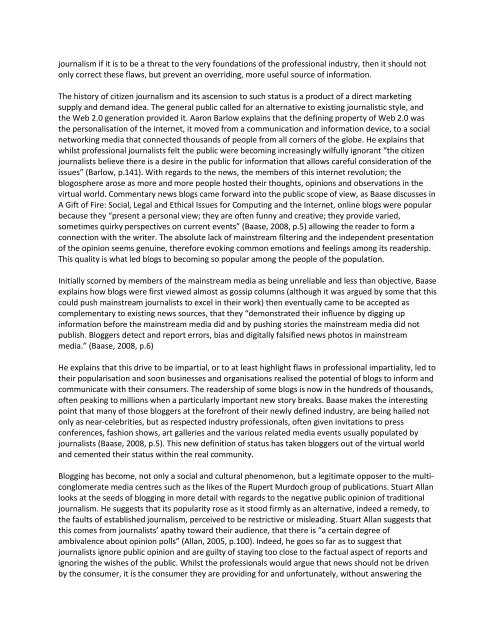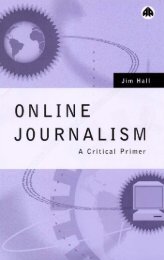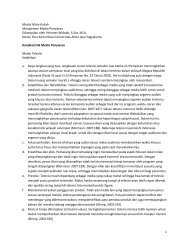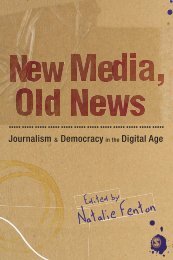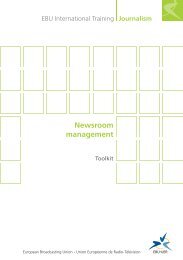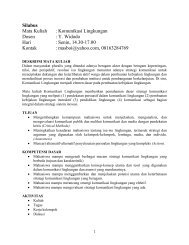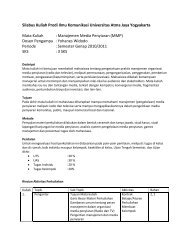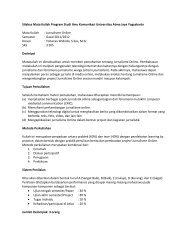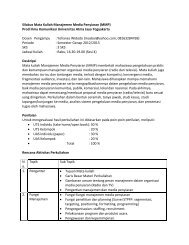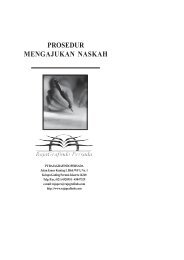Modul Mata Kuliah Journalisme Online - Ayo Menulis FISIP UAJY
Modul Mata Kuliah Journalisme Online - Ayo Menulis FISIP UAJY
Modul Mata Kuliah Journalisme Online - Ayo Menulis FISIP UAJY
You also want an ePaper? Increase the reach of your titles
YUMPU automatically turns print PDFs into web optimized ePapers that Google loves.
journalism if it is to be a threat to the very foundations of the professional industry, then it should not<br />
only correct these flaws, but prevent an overriding, more useful source of information.<br />
The history of citizen journalism and its ascension to such status is a product of a direct marketing<br />
supply and demand idea. The general public called for an alternative to existing journalistic style, and<br />
the Web 2.0 generation provided it. Aaron Barlow explains that the defining property of Web 2.0 was<br />
the personalisation of the internet, it moved from a communication and information device, to a social<br />
networking media that connected thousands of people from all corners of the globe. He explains that<br />
whilst professional journalists felt the public were becoming increasingly wilfully ignorant “the citizen<br />
journalists believe there is a desire in the public for information that allows careful consideration of the<br />
issues” (Barlow, p.141). With regards to the news, the members of this internet revolution; the<br />
blogosphere arose as more and more people hosted their thoughts, opinions and observations in the<br />
virtual world. Commentary news blogs came forward into the public scope of view, as Baase discusses in<br />
A Gift of Fire: Social, Legal and Ethical Issues for Computing and the Internet, online blogs were popular<br />
because they “present a personal view; they are often funny and creative; they provide varied,<br />
sometimes quirky perspectives on current events” (Baase, 2008, p.5) allowing the reader to form a<br />
connection with the writer. The absolute lack of mainstream filtering and the independent presentation<br />
of the opinion seems genuine, therefore evoking common emotions and feelings among its readership.<br />
This quality is what led blogs to becoming so popular among the people of the population.<br />
Initially scorned by members of the mainstream media as being unreliable and less than objective, Baase<br />
explains how blogs were first viewed almost as gossip columns (although it was argued by some that this<br />
could push mainstream journalists to excel in their work) then eventually came to be accepted as<br />
complementary to existing news sources, that they “demonstrated their influence by digging up<br />
information before the mainstream media did and by pushing stories the mainstream media did not<br />
publish. Bloggers detect and report errors, bias and digitally falsified news photos in mainstream<br />
media.” (Baase, 2008, p.6)<br />
He explains that this drive to be impartial, or to at least highlight flaws in professional impartiality, led to<br />
their popularisation and soon businesses and organisations realised the potential of blogs to inform and<br />
communicate with their consumers. The readership of some blogs is now in the hundreds of thousands,<br />
often peaking to millions when a particularly important new story breaks. Baase makes the interesting<br />
point that many of those bloggers at the forefront of their newly defined industry, are being hailed not<br />
only as near-celebrities, but as respected industry professionals, often given invitations to press<br />
conferences, fashion shows, art galleries and the various related media events usually populated by<br />
journalists (Baase, 2008, p.5). This new definition of status has taken bloggers out of the virtual world<br />
and cemented their status within the real community.<br />
Blogging has become, not only a social and cultural phenomenon, but a legitimate opposer to the multiconglomerate<br />
media centres such as the likes of the Rupert Murdoch group of publications. Stuart Allan<br />
looks at the seeds of blogging in more detail with regards to the negative public opinion of traditional<br />
journalism. He suggests that its popularity rose as it stood firmly as an alternative, indeed a remedy, to<br />
the faults of established journalism, perceived to be restrictive or misleading. Stuart Allan suggests that<br />
this comes from journalists’ apathy toward their audience, that there is “a certain degree of<br />
ambivalence about opinion polls” (Allan, 2005, p.100). Indeed, he goes so far as to suggest that<br />
journalists ignore public opinion and are guilty of staying too close to the factual aspect of reports and<br />
ignoring the wishes of the public. Whilst the professionals would argue that news should not be driven<br />
by the consumer, it is the consumer they are providing for and unfortunately, without answering the


